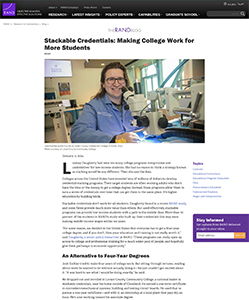
Stackable Credentials: Making College Work for More Students

Lindsay Daugherty had seen too many college programs overpromise and underdeliver for low-income students. She had no reason to think a strategy known as stacking would be any different. Then she saw the data.
Colleges across the United States have invested tens of millions of dollars to develop credential-stacking programs. Their target students are often working adults who don't have the time or the money to get a college degree. Instead, these programs allow them to earn a series of credentials over time that can get them to the same place. It's higher education by building block.
Stackable credentials don't work for all students, Daugherty found in a recent RAND study, and some fields provide much more value than others. But used effectively, stackable programs can provide low-income students with a path to the middle class. More than 70 percent of the students in RAND's study who built up their credentials this way were making middle-income wages within six years.


